Operationalizing & Communicating Value: Bein Edaik UAE Market Analysis
VerifiedAdded on 2021/06/17
|11
|3159
|252
Report
AI Summary
This report provides a comprehensive market analysis of Bein Edaik, a food company, focusing on its operational strategies and customer experience within the UAE market. The analysis employs SWOT, PESTEL, and Porter's Five Forces to assess the business environment, competitive landscape, and potential for growth. The report also examines the company's approach to quality, drawing parallels with Toyota's quality management practices. It explores how Bein Edaik can enhance its customer experience through employee training, and increased activities. The report highlights the importance of understanding customer needs and expectations to ensure product quality and value. The study also discusses the importance of zero defects. The report concludes with a discussion on how Bein Edaik can ensure it delivers value to its customers.
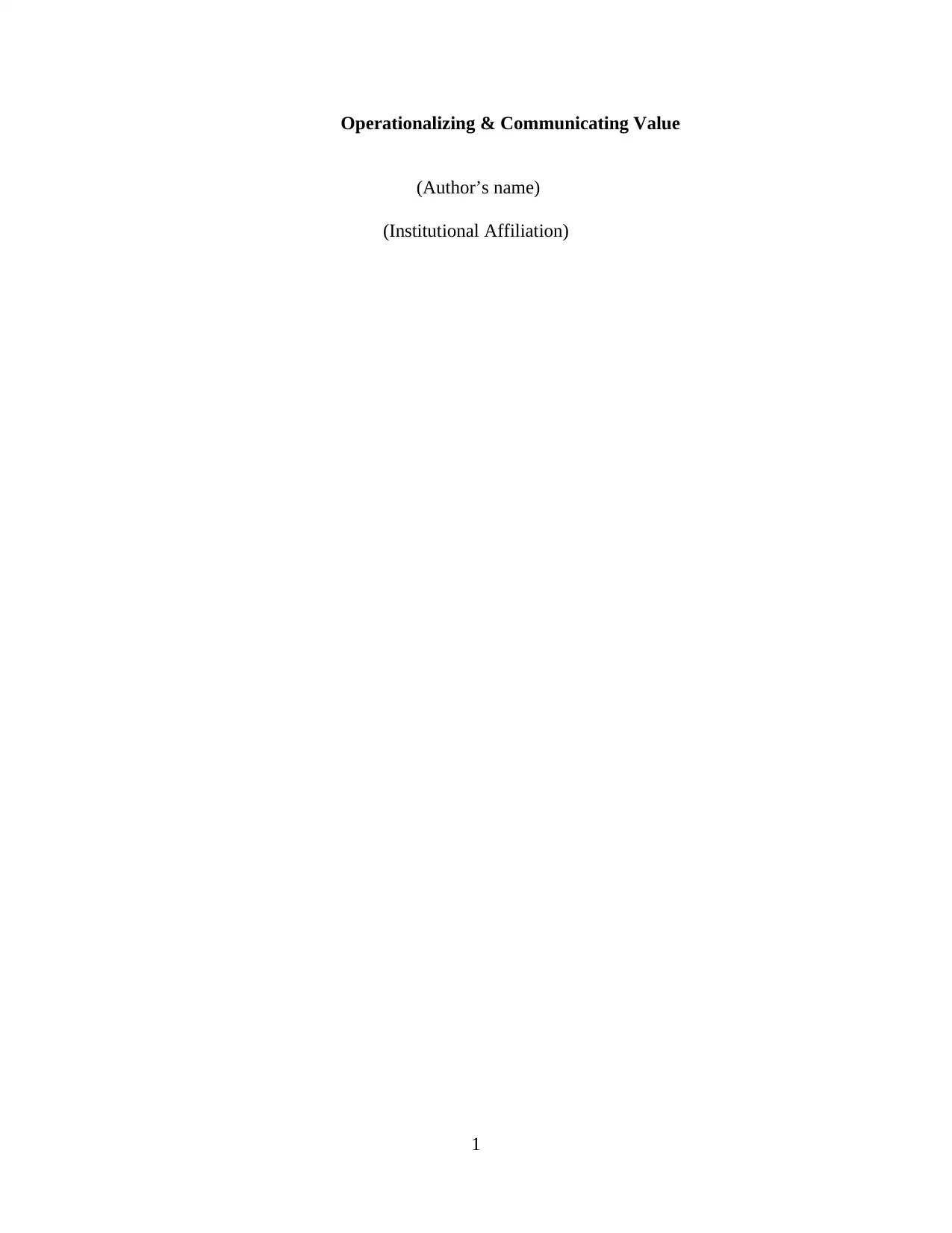
Operationalizing & Communicating Value
(Author’s name)
(Institutional Affiliation)
1
(Author’s name)
(Institutional Affiliation)
1
Paraphrase This Document
Need a fresh take? Get an instant paraphrase of this document with our AI Paraphraser
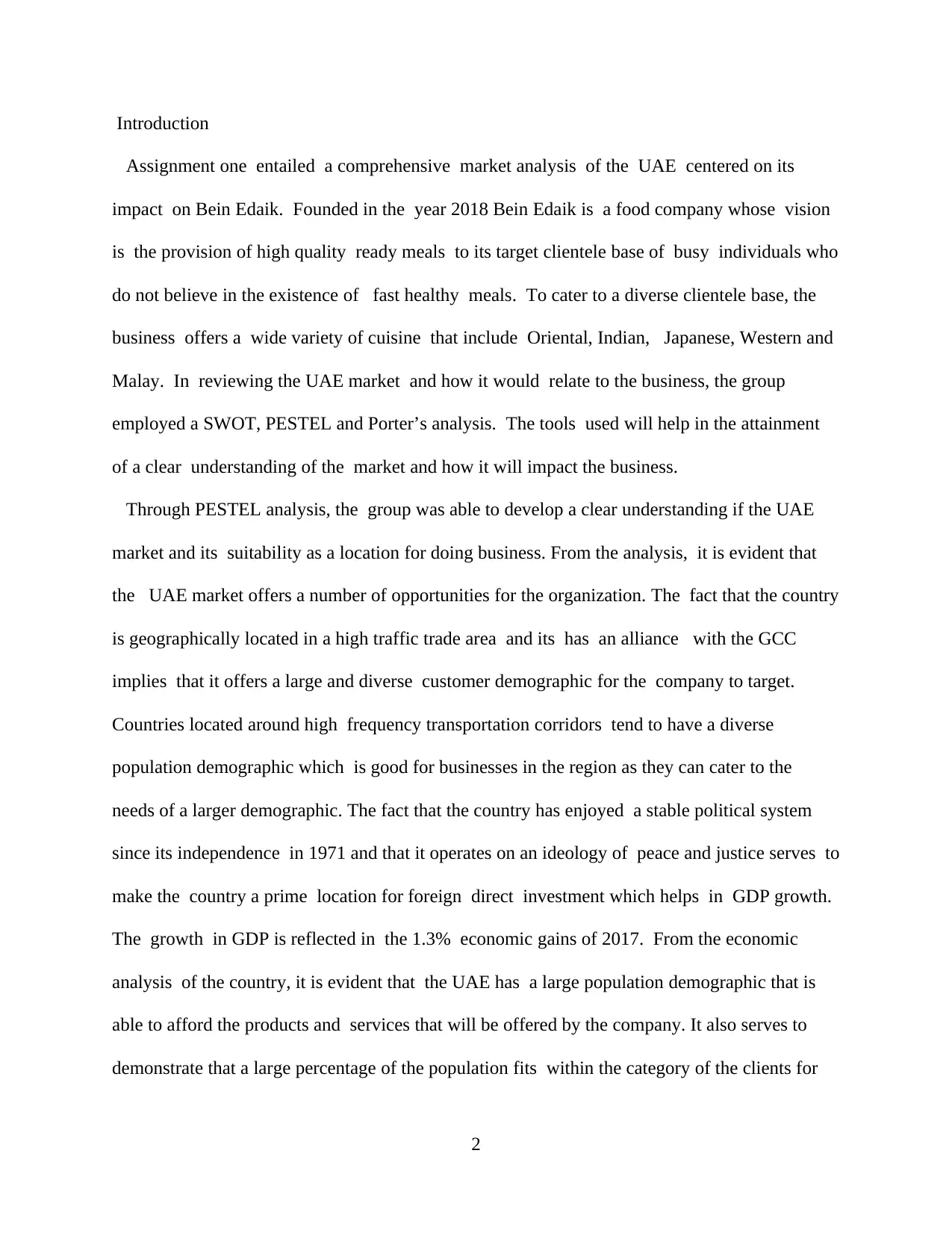
Introduction
Assignment one entailed a comprehensive market analysis of the UAE centered on its
impact on Bein Edaik. Founded in the year 2018 Bein Edaik is a food company whose vision
is the provision of high quality ready meals to its target clientele base of busy individuals who
do not believe in the existence of fast healthy meals. To cater to a diverse clientele base, the
business offers a wide variety of cuisine that include Oriental, Indian, Japanese, Western and
Malay. In reviewing the UAE market and how it would relate to the business, the group
employed a SWOT, PESTEL and Porter’s analysis. The tools used will help in the attainment
of a clear understanding of the market and how it will impact the business.
Through PESTEL analysis, the group was able to develop a clear understanding if the UAE
market and its suitability as a location for doing business. From the analysis, it is evident that
the UAE market offers a number of opportunities for the organization. The fact that the country
is geographically located in a high traffic trade area and its has an alliance with the GCC
implies that it offers a large and diverse customer demographic for the company to target.
Countries located around high frequency transportation corridors tend to have a diverse
population demographic which is good for businesses in the region as they can cater to the
needs of a larger demographic. The fact that the country has enjoyed a stable political system
since its independence in 1971 and that it operates on an ideology of peace and justice serves to
make the country a prime location for foreign direct investment which helps in GDP growth.
The growth in GDP is reflected in the 1.3% economic gains of 2017. From the economic
analysis of the country, it is evident that the UAE has a large population demographic that is
able to afford the products and services that will be offered by the company. It also serves to
demonstrate that a large percentage of the population fits within the category of the clients for
2
Assignment one entailed a comprehensive market analysis of the UAE centered on its
impact on Bein Edaik. Founded in the year 2018 Bein Edaik is a food company whose vision
is the provision of high quality ready meals to its target clientele base of busy individuals who
do not believe in the existence of fast healthy meals. To cater to a diverse clientele base, the
business offers a wide variety of cuisine that include Oriental, Indian, Japanese, Western and
Malay. In reviewing the UAE market and how it would relate to the business, the group
employed a SWOT, PESTEL and Porter’s analysis. The tools used will help in the attainment
of a clear understanding of the market and how it will impact the business.
Through PESTEL analysis, the group was able to develop a clear understanding if the UAE
market and its suitability as a location for doing business. From the analysis, it is evident that
the UAE market offers a number of opportunities for the organization. The fact that the country
is geographically located in a high traffic trade area and its has an alliance with the GCC
implies that it offers a large and diverse customer demographic for the company to target.
Countries located around high frequency transportation corridors tend to have a diverse
population demographic which is good for businesses in the region as they can cater to the
needs of a larger demographic. The fact that the country has enjoyed a stable political system
since its independence in 1971 and that it operates on an ideology of peace and justice serves to
make the country a prime location for foreign direct investment which helps in GDP growth.
The growth in GDP is reflected in the 1.3% economic gains of 2017. From the economic
analysis of the country, it is evident that the UAE has a large population demographic that is
able to afford the products and services that will be offered by the company. It also serves to
demonstrate that a large percentage of the population fits within the category of the clients for
2
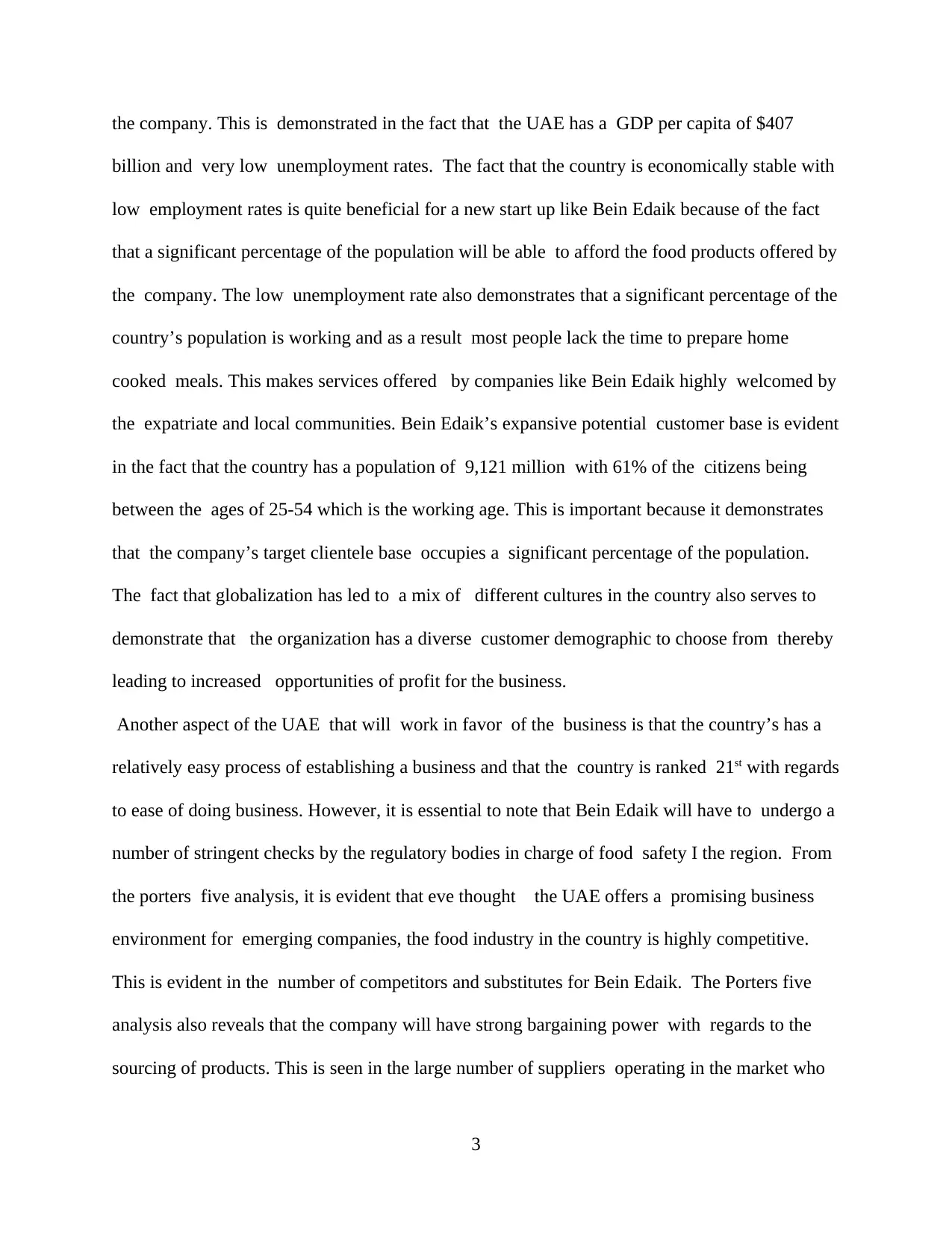
the company. This is demonstrated in the fact that the UAE has a GDP per capita of $407
billion and very low unemployment rates. The fact that the country is economically stable with
low employment rates is quite beneficial for a new start up like Bein Edaik because of the fact
that a significant percentage of the population will be able to afford the food products offered by
the company. The low unemployment rate also demonstrates that a significant percentage of the
country’s population is working and as a result most people lack the time to prepare home
cooked meals. This makes services offered by companies like Bein Edaik highly welcomed by
the expatriate and local communities. Bein Edaik’s expansive potential customer base is evident
in the fact that the country has a population of 9,121 million with 61% of the citizens being
between the ages of 25-54 which is the working age. This is important because it demonstrates
that the company’s target clientele base occupies a significant percentage of the population.
The fact that globalization has led to a mix of different cultures in the country also serves to
demonstrate that the organization has a diverse customer demographic to choose from thereby
leading to increased opportunities of profit for the business.
Another aspect of the UAE that will work in favor of the business is that the country’s has a
relatively easy process of establishing a business and that the country is ranked 21st with regards
to ease of doing business. However, it is essential to note that Bein Edaik will have to undergo a
number of stringent checks by the regulatory bodies in charge of food safety I the region. From
the porters five analysis, it is evident that eve thought the UAE offers a promising business
environment for emerging companies, the food industry in the country is highly competitive.
This is evident in the number of competitors and substitutes for Bein Edaik. The Porters five
analysis also reveals that the company will have strong bargaining power with regards to the
sourcing of products. This is seen in the large number of suppliers operating in the market who
3
billion and very low unemployment rates. The fact that the country is economically stable with
low employment rates is quite beneficial for a new start up like Bein Edaik because of the fact
that a significant percentage of the population will be able to afford the food products offered by
the company. The low unemployment rate also demonstrates that a significant percentage of the
country’s population is working and as a result most people lack the time to prepare home
cooked meals. This makes services offered by companies like Bein Edaik highly welcomed by
the expatriate and local communities. Bein Edaik’s expansive potential customer base is evident
in the fact that the country has a population of 9,121 million with 61% of the citizens being
between the ages of 25-54 which is the working age. This is important because it demonstrates
that the company’s target clientele base occupies a significant percentage of the population.
The fact that globalization has led to a mix of different cultures in the country also serves to
demonstrate that the organization has a diverse customer demographic to choose from thereby
leading to increased opportunities of profit for the business.
Another aspect of the UAE that will work in favor of the business is that the country’s has a
relatively easy process of establishing a business and that the country is ranked 21st with regards
to ease of doing business. However, it is essential to note that Bein Edaik will have to undergo a
number of stringent checks by the regulatory bodies in charge of food safety I the region. From
the porters five analysis, it is evident that eve thought the UAE offers a promising business
environment for emerging companies, the food industry in the country is highly competitive.
This is evident in the number of competitors and substitutes for Bein Edaik. The Porters five
analysis also reveals that the company will have strong bargaining power with regards to the
sourcing of products. This is seen in the large number of suppliers operating in the market who
3
⊘ This is a preview!⊘
Do you want full access?
Subscribe today to unlock all pages.

Trusted by 1+ million students worldwide
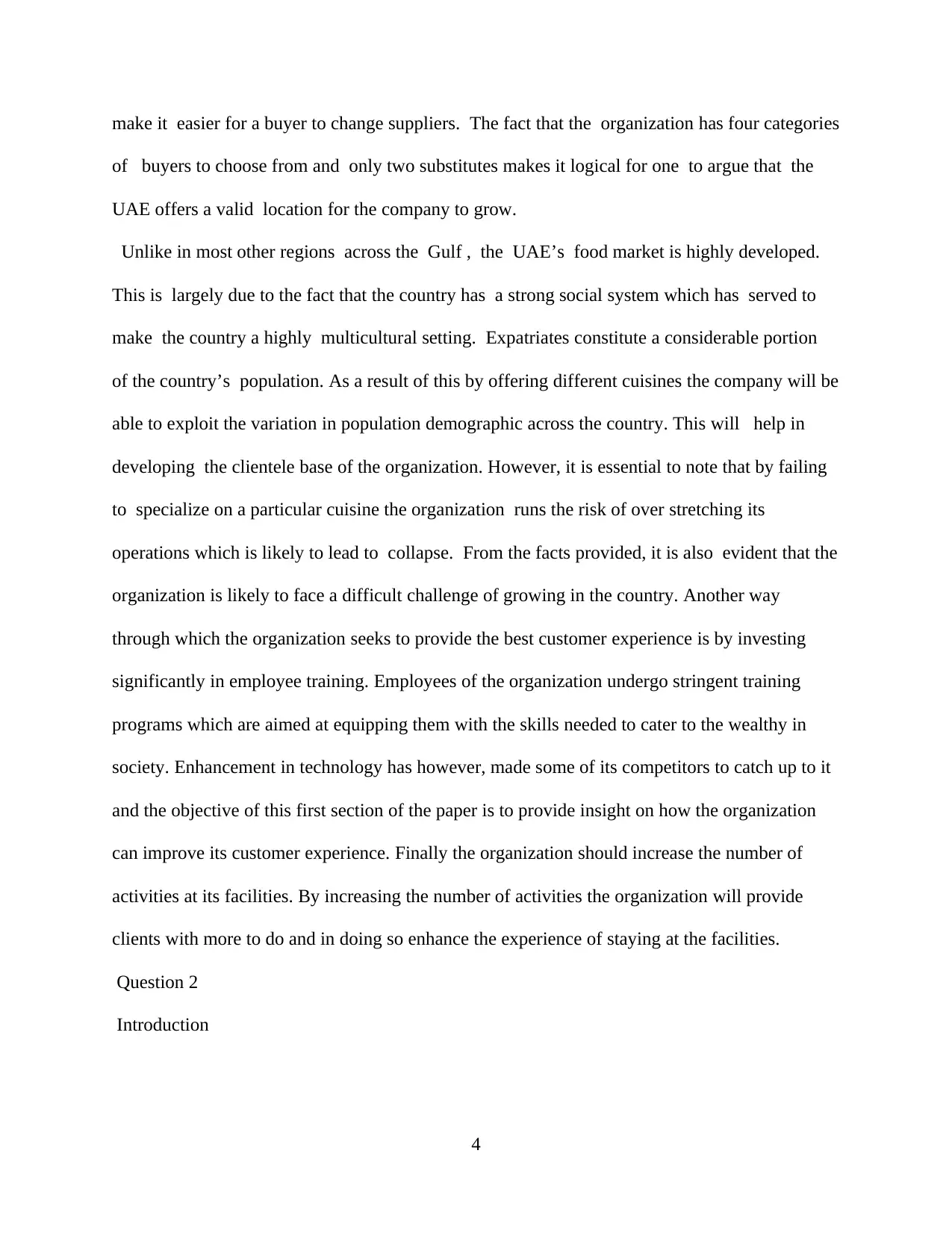
make it easier for a buyer to change suppliers. The fact that the organization has four categories
of buyers to choose from and only two substitutes makes it logical for one to argue that the
UAE offers a valid location for the company to grow.
Unlike in most other regions across the Gulf , the UAE’s food market is highly developed.
This is largely due to the fact that the country has a strong social system which has served to
make the country a highly multicultural setting. Expatriates constitute a considerable portion
of the country’s population. As a result of this by offering different cuisines the company will be
able to exploit the variation in population demographic across the country. This will help in
developing the clientele base of the organization. However, it is essential to note that by failing
to specialize on a particular cuisine the organization runs the risk of over stretching its
operations which is likely to lead to collapse. From the facts provided, it is also evident that the
organization is likely to face a difficult challenge of growing in the country. Another way
through which the organization seeks to provide the best customer experience is by investing
significantly in employee training. Employees of the organization undergo stringent training
programs which are aimed at equipping them with the skills needed to cater to the wealthy in
society. Enhancement in technology has however, made some of its competitors to catch up to it
and the objective of this first section of the paper is to provide insight on how the organization
can improve its customer experience. Finally the organization should increase the number of
activities at its facilities. By increasing the number of activities the organization will provide
clients with more to do and in doing so enhance the experience of staying at the facilities.
Question 2
Introduction
4
of buyers to choose from and only two substitutes makes it logical for one to argue that the
UAE offers a valid location for the company to grow.
Unlike in most other regions across the Gulf , the UAE’s food market is highly developed.
This is largely due to the fact that the country has a strong social system which has served to
make the country a highly multicultural setting. Expatriates constitute a considerable portion
of the country’s population. As a result of this by offering different cuisines the company will be
able to exploit the variation in population demographic across the country. This will help in
developing the clientele base of the organization. However, it is essential to note that by failing
to specialize on a particular cuisine the organization runs the risk of over stretching its
operations which is likely to lead to collapse. From the facts provided, it is also evident that the
organization is likely to face a difficult challenge of growing in the country. Another way
through which the organization seeks to provide the best customer experience is by investing
significantly in employee training. Employees of the organization undergo stringent training
programs which are aimed at equipping them with the skills needed to cater to the wealthy in
society. Enhancement in technology has however, made some of its competitors to catch up to it
and the objective of this first section of the paper is to provide insight on how the organization
can improve its customer experience. Finally the organization should increase the number of
activities at its facilities. By increasing the number of activities the organization will provide
clients with more to do and in doing so enhance the experience of staying at the facilities.
Question 2
Introduction
4
Paraphrase This Document
Need a fresh take? Get an instant paraphrase of this document with our AI Paraphraser
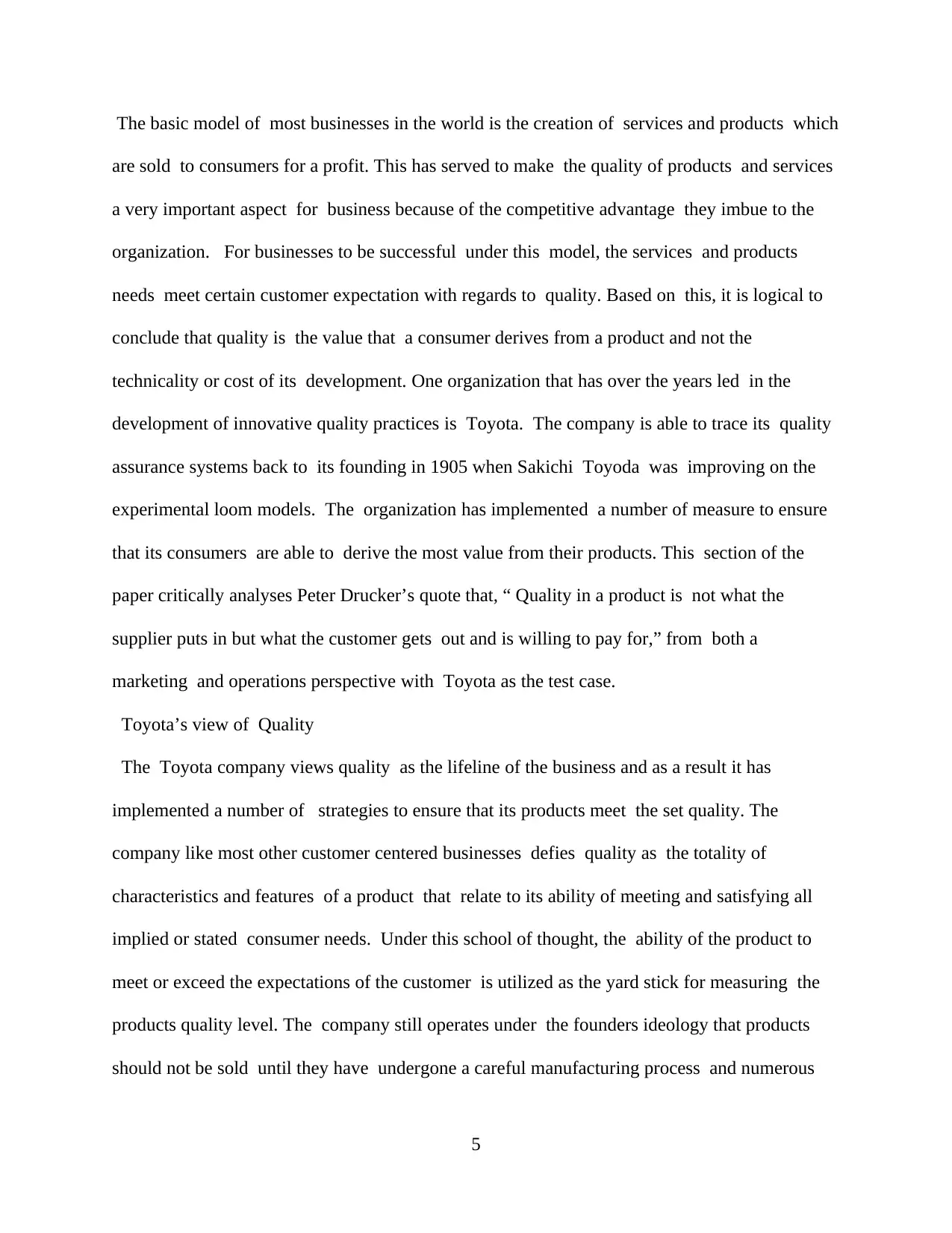
The basic model of most businesses in the world is the creation of services and products which
are sold to consumers for a profit. This has served to make the quality of products and services
a very important aspect for business because of the competitive advantage they imbue to the
organization. For businesses to be successful under this model, the services and products
needs meet certain customer expectation with regards to quality. Based on this, it is logical to
conclude that quality is the value that a consumer derives from a product and not the
technicality or cost of its development. One organization that has over the years led in the
development of innovative quality practices is Toyota. The company is able to trace its quality
assurance systems back to its founding in 1905 when Sakichi Toyoda was improving on the
experimental loom models. The organization has implemented a number of measure to ensure
that its consumers are able to derive the most value from their products. This section of the
paper critically analyses Peter Drucker’s quote that, “ Quality in a product is not what the
supplier puts in but what the customer gets out and is willing to pay for,” from both a
marketing and operations perspective with Toyota as the test case.
Toyota’s view of Quality
The Toyota company views quality as the lifeline of the business and as a result it has
implemented a number of strategies to ensure that its products meet the set quality. The
company like most other customer centered businesses defies quality as the totality of
characteristics and features of a product that relate to its ability of meeting and satisfying all
implied or stated consumer needs. Under this school of thought, the ability of the product to
meet or exceed the expectations of the customer is utilized as the yard stick for measuring the
products quality level. The company still operates under the founders ideology that products
should not be sold until they have undergone a careful manufacturing process and numerous
5
are sold to consumers for a profit. This has served to make the quality of products and services
a very important aspect for business because of the competitive advantage they imbue to the
organization. For businesses to be successful under this model, the services and products
needs meet certain customer expectation with regards to quality. Based on this, it is logical to
conclude that quality is the value that a consumer derives from a product and not the
technicality or cost of its development. One organization that has over the years led in the
development of innovative quality practices is Toyota. The company is able to trace its quality
assurance systems back to its founding in 1905 when Sakichi Toyoda was improving on the
experimental loom models. The organization has implemented a number of measure to ensure
that its consumers are able to derive the most value from their products. This section of the
paper critically analyses Peter Drucker’s quote that, “ Quality in a product is not what the
supplier puts in but what the customer gets out and is willing to pay for,” from both a
marketing and operations perspective with Toyota as the test case.
Toyota’s view of Quality
The Toyota company views quality as the lifeline of the business and as a result it has
implemented a number of strategies to ensure that its products meet the set quality. The
company like most other customer centered businesses defies quality as the totality of
characteristics and features of a product that relate to its ability of meeting and satisfying all
implied or stated consumer needs. Under this school of thought, the ability of the product to
meet or exceed the expectations of the customer is utilized as the yard stick for measuring the
products quality level. The company still operates under the founders ideology that products
should not be sold until they have undergone a careful manufacturing process and numerous
5
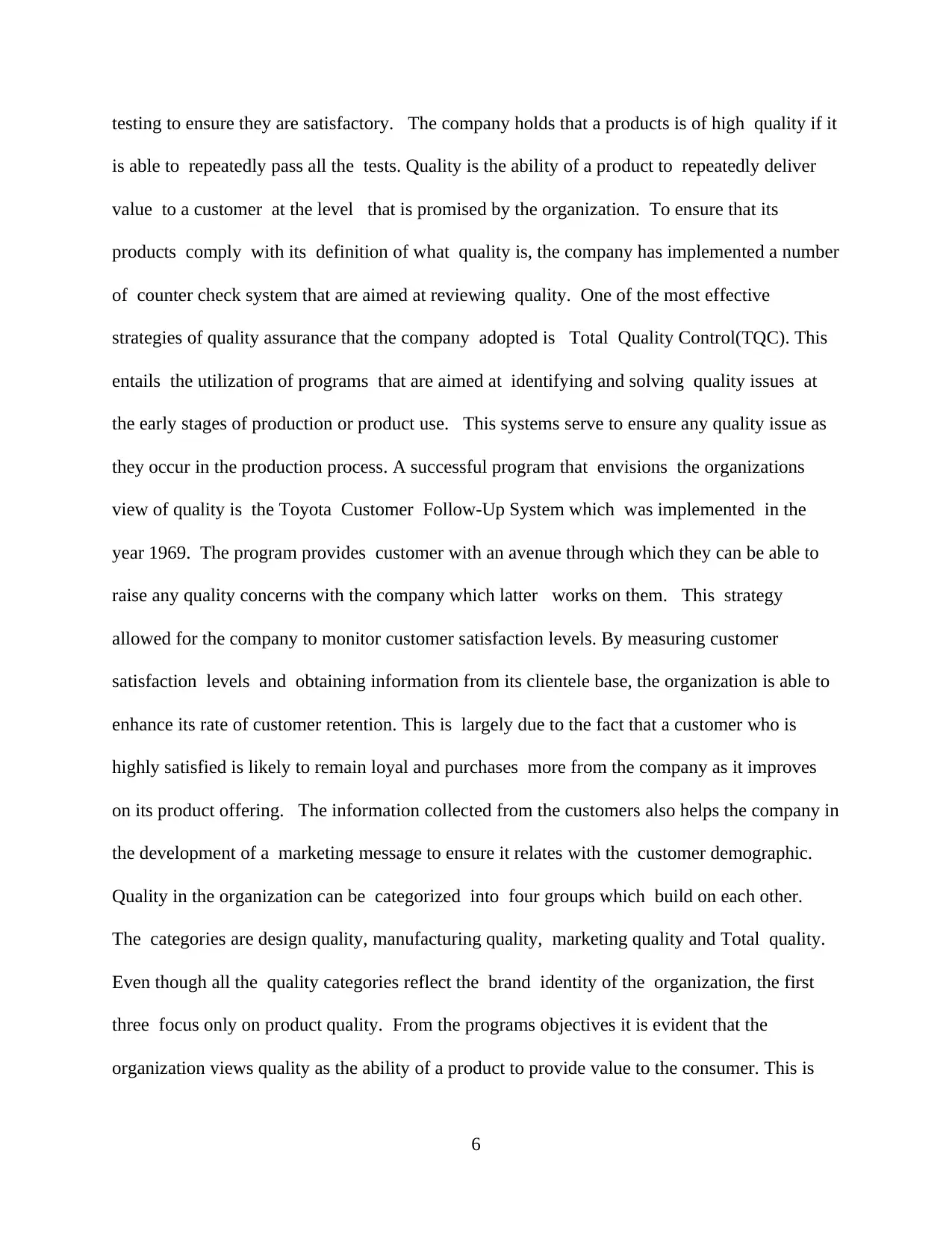
testing to ensure they are satisfactory. The company holds that a products is of high quality if it
is able to repeatedly pass all the tests. Quality is the ability of a product to repeatedly deliver
value to a customer at the level that is promised by the organization. To ensure that its
products comply with its definition of what quality is, the company has implemented a number
of counter check system that are aimed at reviewing quality. One of the most effective
strategies of quality assurance that the company adopted is Total Quality Control(TQC). This
entails the utilization of programs that are aimed at identifying and solving quality issues at
the early stages of production or product use. This systems serve to ensure any quality issue as
they occur in the production process. A successful program that envisions the organizations
view of quality is the Toyota Customer Follow-Up System which was implemented in the
year 1969. The program provides customer with an avenue through which they can be able to
raise any quality concerns with the company which latter works on them. This strategy
allowed for the company to monitor customer satisfaction levels. By measuring customer
satisfaction levels and obtaining information from its clientele base, the organization is able to
enhance its rate of customer retention. This is largely due to the fact that a customer who is
highly satisfied is likely to remain loyal and purchases more from the company as it improves
on its product offering. The information collected from the customers also helps the company in
the development of a marketing message to ensure it relates with the customer demographic.
Quality in the organization can be categorized into four groups which build on each other.
The categories are design quality, manufacturing quality, marketing quality and Total quality.
Even though all the quality categories reflect the brand identity of the organization, the first
three focus only on product quality. From the programs objectives it is evident that the
organization views quality as the ability of a product to provide value to the consumer. This is
6
is able to repeatedly pass all the tests. Quality is the ability of a product to repeatedly deliver
value to a customer at the level that is promised by the organization. To ensure that its
products comply with its definition of what quality is, the company has implemented a number
of counter check system that are aimed at reviewing quality. One of the most effective
strategies of quality assurance that the company adopted is Total Quality Control(TQC). This
entails the utilization of programs that are aimed at identifying and solving quality issues at
the early stages of production or product use. This systems serve to ensure any quality issue as
they occur in the production process. A successful program that envisions the organizations
view of quality is the Toyota Customer Follow-Up System which was implemented in the
year 1969. The program provides customer with an avenue through which they can be able to
raise any quality concerns with the company which latter works on them. This strategy
allowed for the company to monitor customer satisfaction levels. By measuring customer
satisfaction levels and obtaining information from its clientele base, the organization is able to
enhance its rate of customer retention. This is largely due to the fact that a customer who is
highly satisfied is likely to remain loyal and purchases more from the company as it improves
on its product offering. The information collected from the customers also helps the company in
the development of a marketing message to ensure it relates with the customer demographic.
Quality in the organization can be categorized into four groups which build on each other.
The categories are design quality, manufacturing quality, marketing quality and Total quality.
Even though all the quality categories reflect the brand identity of the organization, the first
three focus only on product quality. From the programs objectives it is evident that the
organization views quality as the ability of a product to provide value to the consumer. This is
6
⊘ This is a preview!⊘
Do you want full access?
Subscribe today to unlock all pages.

Trusted by 1+ million students worldwide
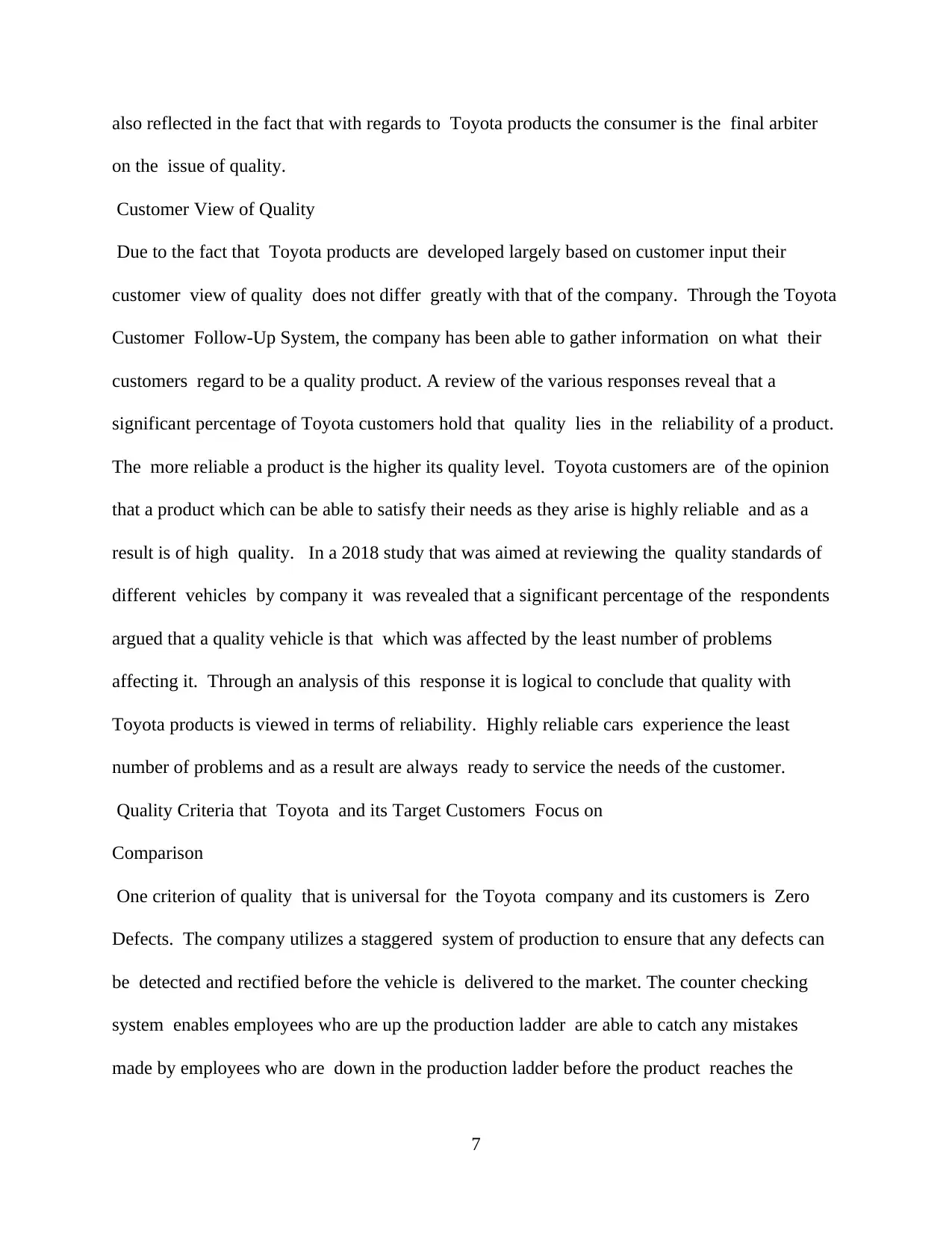
also reflected in the fact that with regards to Toyota products the consumer is the final arbiter
on the issue of quality.
Customer View of Quality
Due to the fact that Toyota products are developed largely based on customer input their
customer view of quality does not differ greatly with that of the company. Through the Toyota
Customer Follow-Up System, the company has been able to gather information on what their
customers regard to be a quality product. A review of the various responses reveal that a
significant percentage of Toyota customers hold that quality lies in the reliability of a product.
The more reliable a product is the higher its quality level. Toyota customers are of the opinion
that a product which can be able to satisfy their needs as they arise is highly reliable and as a
result is of high quality. In a 2018 study that was aimed at reviewing the quality standards of
different vehicles by company it was revealed that a significant percentage of the respondents
argued that a quality vehicle is that which was affected by the least number of problems
affecting it. Through an analysis of this response it is logical to conclude that quality with
Toyota products is viewed in terms of reliability. Highly reliable cars experience the least
number of problems and as a result are always ready to service the needs of the customer.
Quality Criteria that Toyota and its Target Customers Focus on
Comparison
One criterion of quality that is universal for the Toyota company and its customers is Zero
Defects. The company utilizes a staggered system of production to ensure that any defects can
be detected and rectified before the vehicle is delivered to the market. The counter checking
system enables employees who are up the production ladder are able to catch any mistakes
made by employees who are down in the production ladder before the product reaches the
7
on the issue of quality.
Customer View of Quality
Due to the fact that Toyota products are developed largely based on customer input their
customer view of quality does not differ greatly with that of the company. Through the Toyota
Customer Follow-Up System, the company has been able to gather information on what their
customers regard to be a quality product. A review of the various responses reveal that a
significant percentage of Toyota customers hold that quality lies in the reliability of a product.
The more reliable a product is the higher its quality level. Toyota customers are of the opinion
that a product which can be able to satisfy their needs as they arise is highly reliable and as a
result is of high quality. In a 2018 study that was aimed at reviewing the quality standards of
different vehicles by company it was revealed that a significant percentage of the respondents
argued that a quality vehicle is that which was affected by the least number of problems
affecting it. Through an analysis of this response it is logical to conclude that quality with
Toyota products is viewed in terms of reliability. Highly reliable cars experience the least
number of problems and as a result are always ready to service the needs of the customer.
Quality Criteria that Toyota and its Target Customers Focus on
Comparison
One criterion of quality that is universal for the Toyota company and its customers is Zero
Defects. The company utilizes a staggered system of production to ensure that any defects can
be detected and rectified before the vehicle is delivered to the market. The counter checking
system enables employees who are up the production ladder are able to catch any mistakes
made by employees who are down in the production ladder before the product reaches the
7
Paraphrase This Document
Need a fresh take? Get an instant paraphrase of this document with our AI Paraphraser
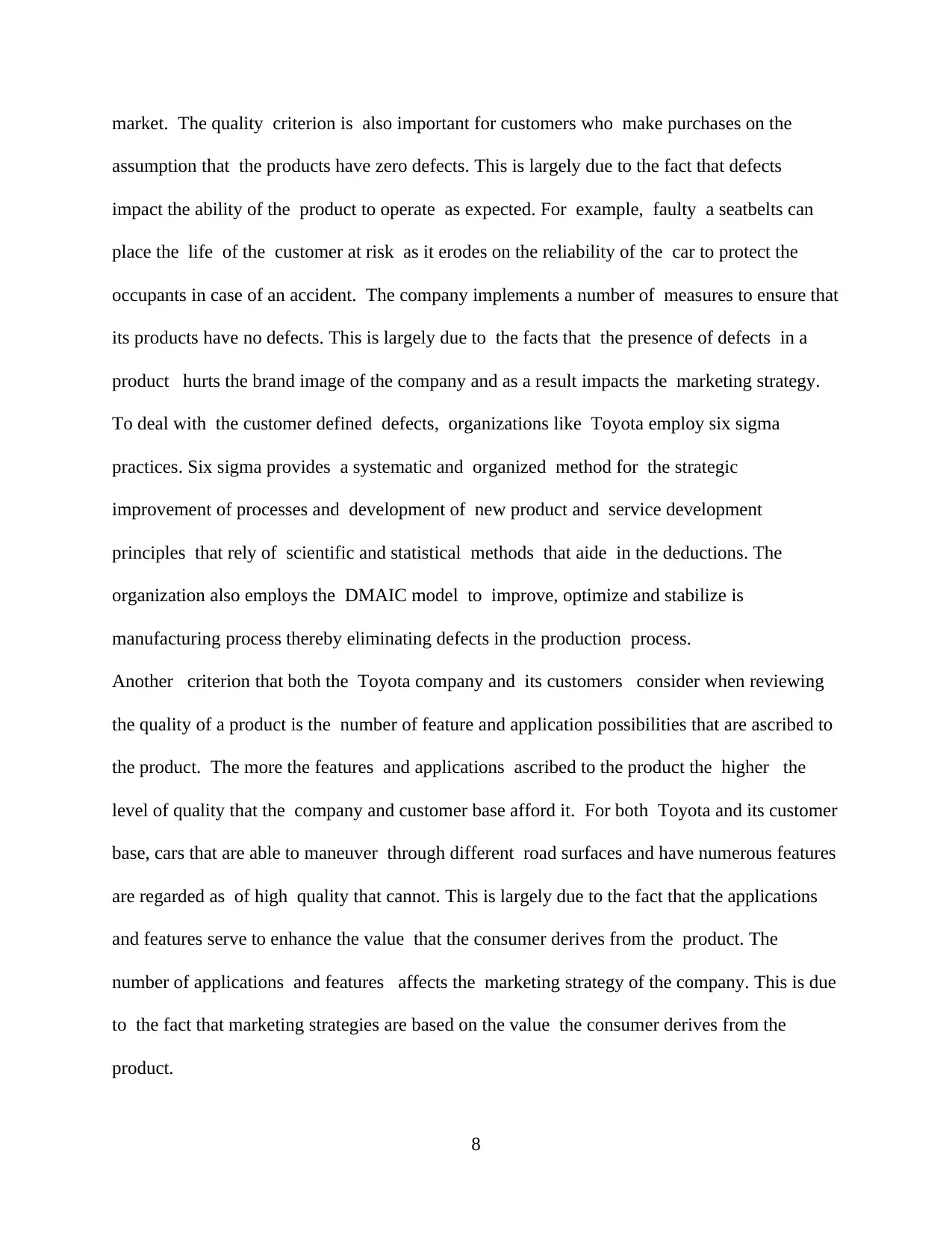
market. The quality criterion is also important for customers who make purchases on the
assumption that the products have zero defects. This is largely due to the fact that defects
impact the ability of the product to operate as expected. For example, faulty a seatbelts can
place the life of the customer at risk as it erodes on the reliability of the car to protect the
occupants in case of an accident. The company implements a number of measures to ensure that
its products have no defects. This is largely due to the facts that the presence of defects in a
product hurts the brand image of the company and as a result impacts the marketing strategy.
To deal with the customer defined defects, organizations like Toyota employ six sigma
practices. Six sigma provides a systematic and organized method for the strategic
improvement of processes and development of new product and service development
principles that rely of scientific and statistical methods that aide in the deductions. The
organization also employs the DMAIC model to improve, optimize and stabilize is
manufacturing process thereby eliminating defects in the production process.
Another criterion that both the Toyota company and its customers consider when reviewing
the quality of a product is the number of feature and application possibilities that are ascribed to
the product. The more the features and applications ascribed to the product the higher the
level of quality that the company and customer base afford it. For both Toyota and its customer
base, cars that are able to maneuver through different road surfaces and have numerous features
are regarded as of high quality that cannot. This is largely due to the fact that the applications
and features serve to enhance the value that the consumer derives from the product. The
number of applications and features affects the marketing strategy of the company. This is due
to the fact that marketing strategies are based on the value the consumer derives from the
product.
8
assumption that the products have zero defects. This is largely due to the fact that defects
impact the ability of the product to operate as expected. For example, faulty a seatbelts can
place the life of the customer at risk as it erodes on the reliability of the car to protect the
occupants in case of an accident. The company implements a number of measures to ensure that
its products have no defects. This is largely due to the facts that the presence of defects in a
product hurts the brand image of the company and as a result impacts the marketing strategy.
To deal with the customer defined defects, organizations like Toyota employ six sigma
practices. Six sigma provides a systematic and organized method for the strategic
improvement of processes and development of new product and service development
principles that rely of scientific and statistical methods that aide in the deductions. The
organization also employs the DMAIC model to improve, optimize and stabilize is
manufacturing process thereby eliminating defects in the production process.
Another criterion that both the Toyota company and its customers consider when reviewing
the quality of a product is the number of feature and application possibilities that are ascribed to
the product. The more the features and applications ascribed to the product the higher the
level of quality that the company and customer base afford it. For both Toyota and its customer
base, cars that are able to maneuver through different road surfaces and have numerous features
are regarded as of high quality that cannot. This is largely due to the fact that the applications
and features serve to enhance the value that the consumer derives from the product. The
number of applications and features affects the marketing strategy of the company. This is due
to the fact that marketing strategies are based on the value the consumer derives from the
product.
8
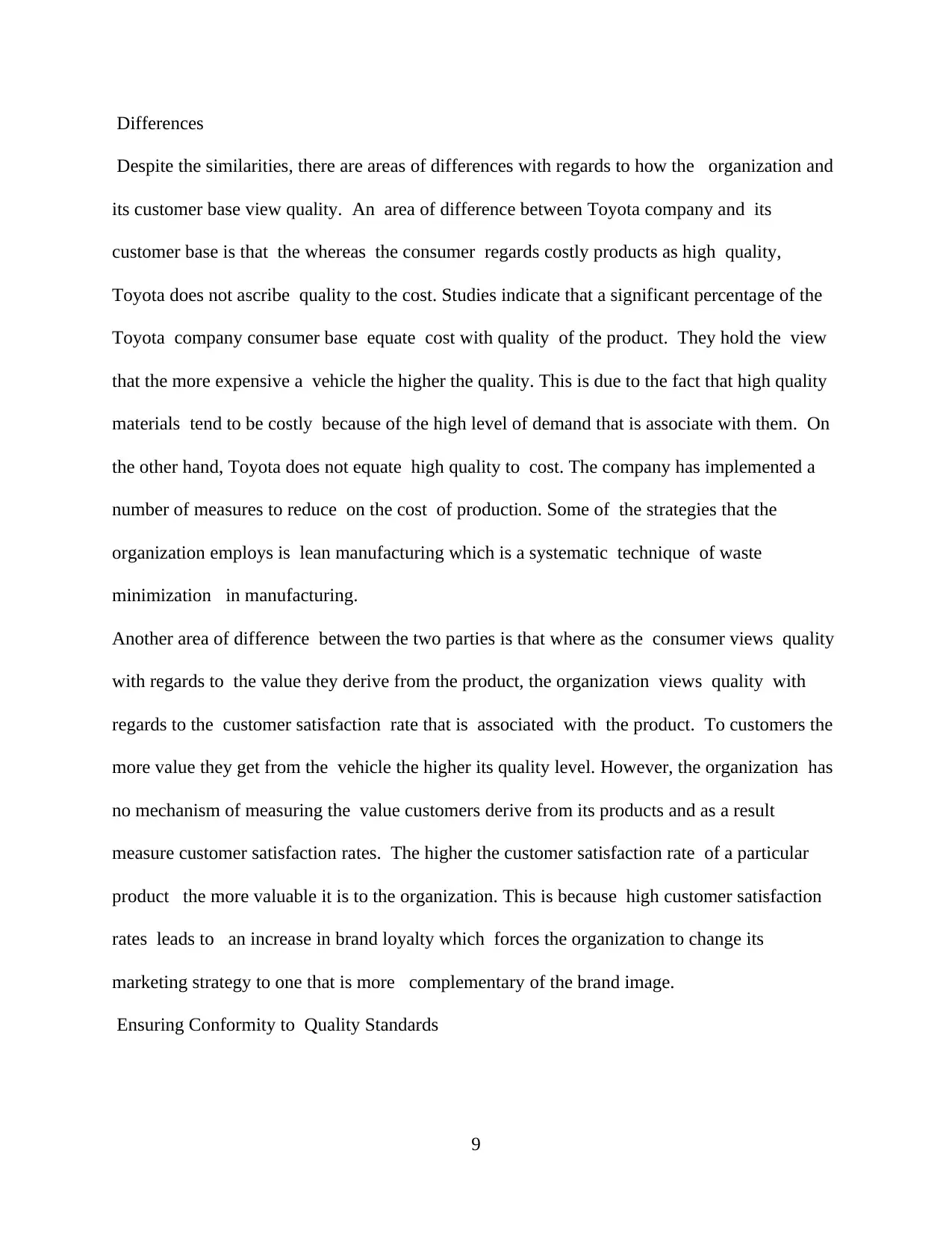
Differences
Despite the similarities, there are areas of differences with regards to how the organization and
its customer base view quality. An area of difference between Toyota company and its
customer base is that the whereas the consumer regards costly products as high quality,
Toyota does not ascribe quality to the cost. Studies indicate that a significant percentage of the
Toyota company consumer base equate cost with quality of the product. They hold the view
that the more expensive a vehicle the higher the quality. This is due to the fact that high quality
materials tend to be costly because of the high level of demand that is associate with them. On
the other hand, Toyota does not equate high quality to cost. The company has implemented a
number of measures to reduce on the cost of production. Some of the strategies that the
organization employs is lean manufacturing which is a systematic technique of waste
minimization in manufacturing.
Another area of difference between the two parties is that where as the consumer views quality
with regards to the value they derive from the product, the organization views quality with
regards to the customer satisfaction rate that is associated with the product. To customers the
more value they get from the vehicle the higher its quality level. However, the organization has
no mechanism of measuring the value customers derive from its products and as a result
measure customer satisfaction rates. The higher the customer satisfaction rate of a particular
product the more valuable it is to the organization. This is because high customer satisfaction
rates leads to an increase in brand loyalty which forces the organization to change its
marketing strategy to one that is more complementary of the brand image.
Ensuring Conformity to Quality Standards
9
Despite the similarities, there are areas of differences with regards to how the organization and
its customer base view quality. An area of difference between Toyota company and its
customer base is that the whereas the consumer regards costly products as high quality,
Toyota does not ascribe quality to the cost. Studies indicate that a significant percentage of the
Toyota company consumer base equate cost with quality of the product. They hold the view
that the more expensive a vehicle the higher the quality. This is due to the fact that high quality
materials tend to be costly because of the high level of demand that is associate with them. On
the other hand, Toyota does not equate high quality to cost. The company has implemented a
number of measures to reduce on the cost of production. Some of the strategies that the
organization employs is lean manufacturing which is a systematic technique of waste
minimization in manufacturing.
Another area of difference between the two parties is that where as the consumer views quality
with regards to the value they derive from the product, the organization views quality with
regards to the customer satisfaction rate that is associated with the product. To customers the
more value they get from the vehicle the higher its quality level. However, the organization has
no mechanism of measuring the value customers derive from its products and as a result
measure customer satisfaction rates. The higher the customer satisfaction rate of a particular
product the more valuable it is to the organization. This is because high customer satisfaction
rates leads to an increase in brand loyalty which forces the organization to change its
marketing strategy to one that is more complementary of the brand image.
Ensuring Conformity to Quality Standards
9
⊘ This is a preview!⊘
Do you want full access?
Subscribe today to unlock all pages.

Trusted by 1+ million students worldwide
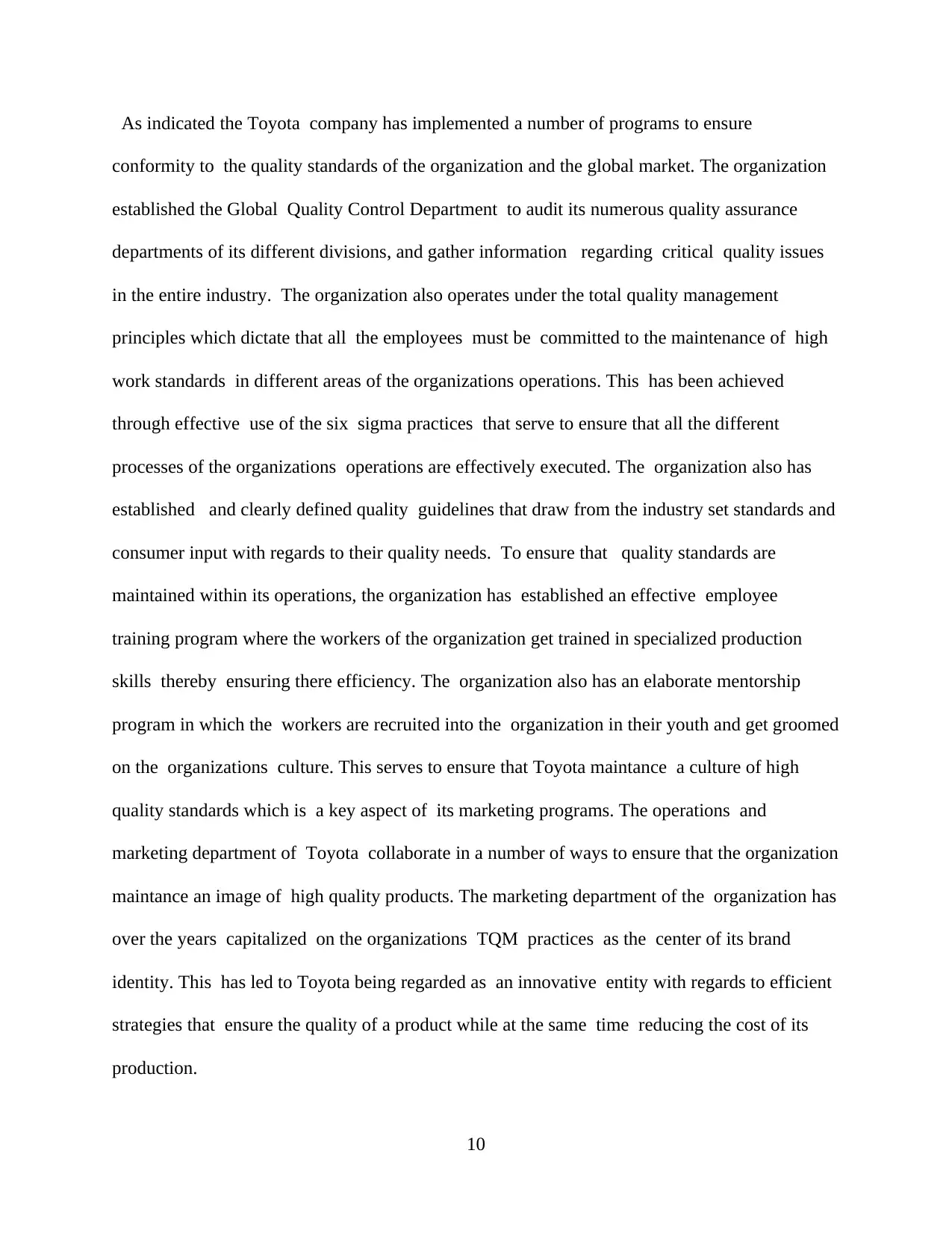
As indicated the Toyota company has implemented a number of programs to ensure
conformity to the quality standards of the organization and the global market. The organization
established the Global Quality Control Department to audit its numerous quality assurance
departments of its different divisions, and gather information regarding critical quality issues
in the entire industry. The organization also operates under the total quality management
principles which dictate that all the employees must be committed to the maintenance of high
work standards in different areas of the organizations operations. This has been achieved
through effective use of the six sigma practices that serve to ensure that all the different
processes of the organizations operations are effectively executed. The organization also has
established and clearly defined quality guidelines that draw from the industry set standards and
consumer input with regards to their quality needs. To ensure that quality standards are
maintained within its operations, the organization has established an effective employee
training program where the workers of the organization get trained in specialized production
skills thereby ensuring there efficiency. The organization also has an elaborate mentorship
program in which the workers are recruited into the organization in their youth and get groomed
on the organizations culture. This serves to ensure that Toyota maintance a culture of high
quality standards which is a key aspect of its marketing programs. The operations and
marketing department of Toyota collaborate in a number of ways to ensure that the organization
maintance an image of high quality products. The marketing department of the organization has
over the years capitalized on the organizations TQM practices as the center of its brand
identity. This has led to Toyota being regarded as an innovative entity with regards to efficient
strategies that ensure the quality of a product while at the same time reducing the cost of its
production.
10
conformity to the quality standards of the organization and the global market. The organization
established the Global Quality Control Department to audit its numerous quality assurance
departments of its different divisions, and gather information regarding critical quality issues
in the entire industry. The organization also operates under the total quality management
principles which dictate that all the employees must be committed to the maintenance of high
work standards in different areas of the organizations operations. This has been achieved
through effective use of the six sigma practices that serve to ensure that all the different
processes of the organizations operations are effectively executed. The organization also has
established and clearly defined quality guidelines that draw from the industry set standards and
consumer input with regards to their quality needs. To ensure that quality standards are
maintained within its operations, the organization has established an effective employee
training program where the workers of the organization get trained in specialized production
skills thereby ensuring there efficiency. The organization also has an elaborate mentorship
program in which the workers are recruited into the organization in their youth and get groomed
on the organizations culture. This serves to ensure that Toyota maintance a culture of high
quality standards which is a key aspect of its marketing programs. The operations and
marketing department of Toyota collaborate in a number of ways to ensure that the organization
maintance an image of high quality products. The marketing department of the organization has
over the years capitalized on the organizations TQM practices as the center of its brand
identity. This has led to Toyota being regarded as an innovative entity with regards to efficient
strategies that ensure the quality of a product while at the same time reducing the cost of its
production.
10
Paraphrase This Document
Need a fresh take? Get an instant paraphrase of this document with our AI Paraphraser

11
1 out of 11
Related Documents
Your All-in-One AI-Powered Toolkit for Academic Success.
+13062052269
info@desklib.com
Available 24*7 on WhatsApp / Email
![[object Object]](/_next/static/media/star-bottom.7253800d.svg)
Unlock your academic potential
Copyright © 2020–2025 A2Z Services. All Rights Reserved. Developed and managed by ZUCOL.





